Teams can be divided into four main groups: project teams, self-managed teams, virtual teams, and operational teams. What type of team you have depends on its purpose, location, and organizational structure. Each type of team comes with its unique set of strengths and weaknesses. In order to fully utilize your team, you first need to understand where each type of team works the best.
At the bottom of this post, you'll find a cheat sheet with an overview of all the types of teams, their main characteristics, pros, and cons!
Project Teams
Project teams are groups of employees who work collectively toward shared goals. This type of team allows you to structure work in a specific, measurable, and time-constrained way. You can assign clear roles, responsibilities, and deadlines. Also, by selecting both experienced and inexperienced workers, you enable them to do informal coaching and mentoring.
There are four main types of project teams:
Functional Teams
These teams are permanent and always include members of the same department with different responsibilities. A manager is responsible for everything, and everyone reports to him. These types of teams are more likely to be found in companies that incorporate traditional project management.
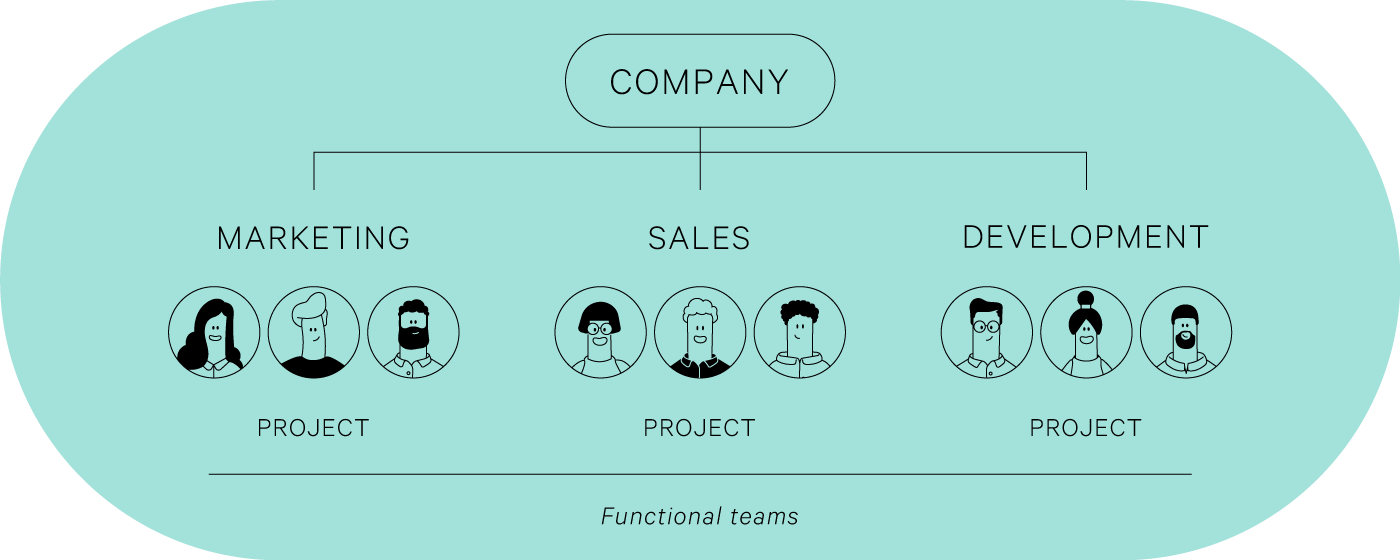
Sometimes, in order to complete a project, several departments need to work together. For example:
- Work on the new product starts with the idea from the marketing department;
- The idea is passed down to research and development to determine its feasibility;
- After R&D, the design department is tasked with giving it an appealing look and feel;
- And finally, the product is made by the manufacturing department.
This type of approach is known as ‘baton passing’. It requires a manager that has oversight of the entire project and ensures that there are no obstacles when it comes to transferring work from one team to another.
Advantages and Disadvantages of Functional Teams
Advantages:
- Handles routine work
- Line management has control of projects
- Pools technical and professional expertise
Disadvantages:
- Difficult communication across areas
- Pushing the decision-making process upwards
- Inflexible
Cross-functional Teams
Cross-functional teams are made up of members from various departments. These teams tackle specific tasks that require different inputs and expertise. Even though cross-functional teams are becoming increasingly popular worldwide, a recent study has proven that a whopping 75% of all cross-functional teams are dysfunctional.
.png)
Advantages and Disadvantages of Cross-functional Teams
Advantages:
- Greater speed of task completion
- Can handle a wide array of projects
- Source of unconventional ideas
Disadvantages:
- Takes a long time to develop cohesion
- Management can prove to be challenging
- Diversity can cause conflict
Matrix Teams
These teams are characterized by a “two-boss system”, where an individual reports to a different manager for various aspects of his work. This type of team is the product of the Matrix management approach.
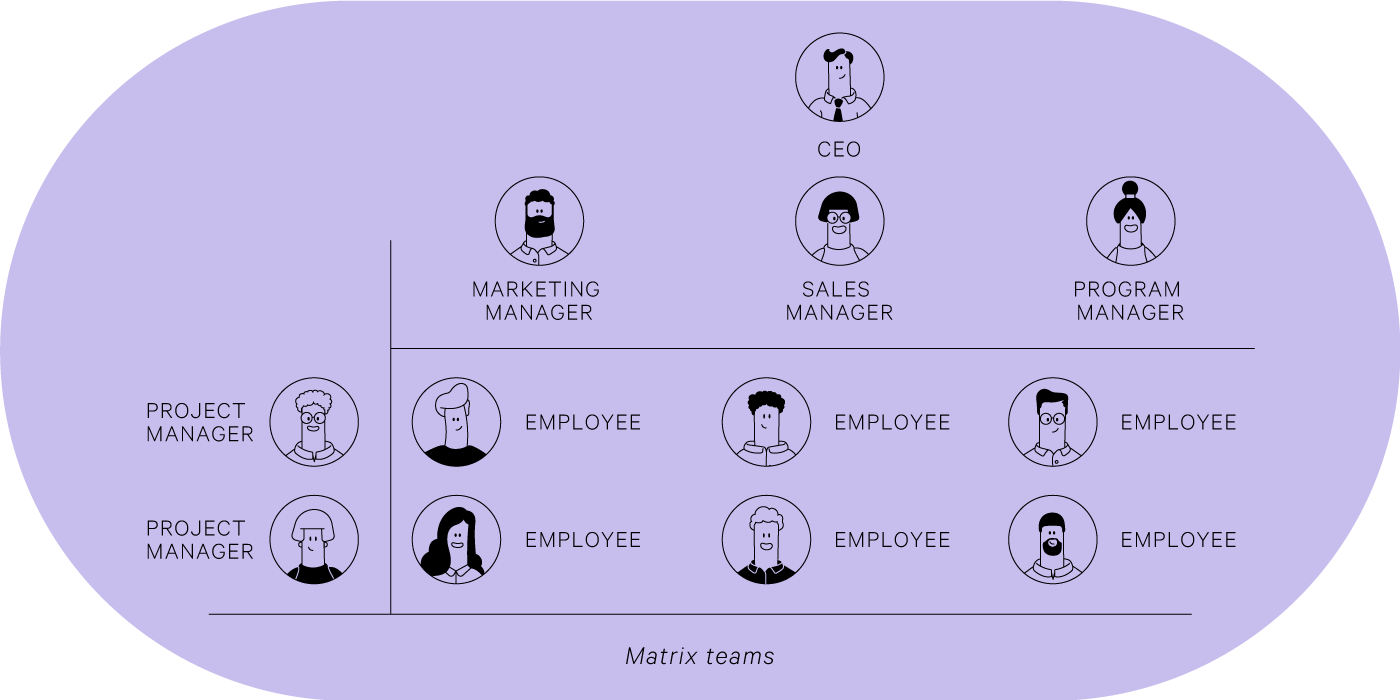
Let’s say Jeff, a designer, was given the task of making a design for a new product that marketing provided an idea for and that R&D deemed feasible. By being included in this project, Jeff all of a sudden has two bosses: the first one is a project manager who only cares about the design being done, while the other one is his functional line manager who’s in charge of Jeff’s training, career development, and routine tasks.
[Find our cheat sheet with all these types of teams on one page at the bottom of this post]
While this approach helps the top management retain control over the project without being included in day-to-day decisions, employees are often faced with challenges of dual command: Jeff now has to report to two managers, who might give him conflict instructions, which causes confusion and frustration.
Advantages and Disadvantages of Matrix Teams
Advantages:
- Acceptable to traditional managers
- Flexibility for assigned personnel
- Top management controls projects, stays out of daily activities
Disadvantages:
- Dual reporting
- The team leader is usually unable to choose who will be on the project
- Difficult performance appraisal
Contract Teams
Contract teams are outsourced teams that are tied down by a contract and brought in to complete a part of a project. After the project is completed and the contract has ended, the client can cut all ties to the team, no questions asked.
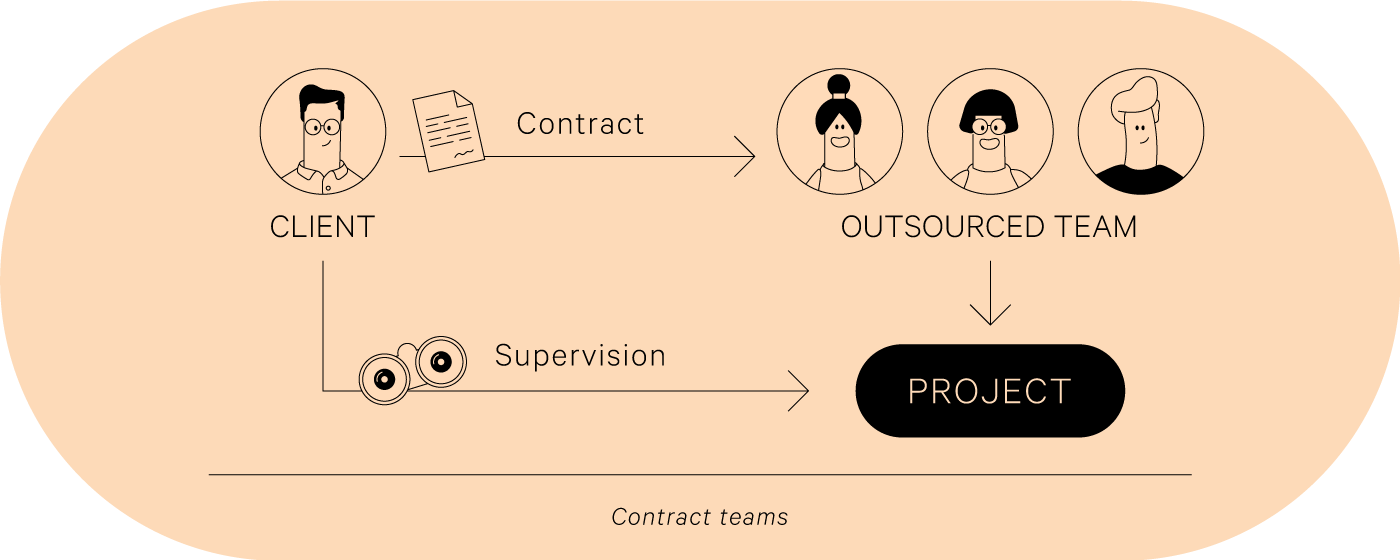
The project manager is the key to success when it comes to contract teams. The project manager has to:
- maintain constant communication between the team and the client,
- compensate for the lack of a team’s physical presence (given that most contract teams work remotely),
- bear full responsibility for the success or failure of a project
Advantages and Disadvantages of Contract Teams
Advantages:
- Easy employment of experts
- A team can use the existing management structure
- No need for client training
Disadvantages:
- Difficult assessment of project progress for the client
- Difficult to resolve political and organizational issues
- The client is the only judge of success
Self-managed Teams
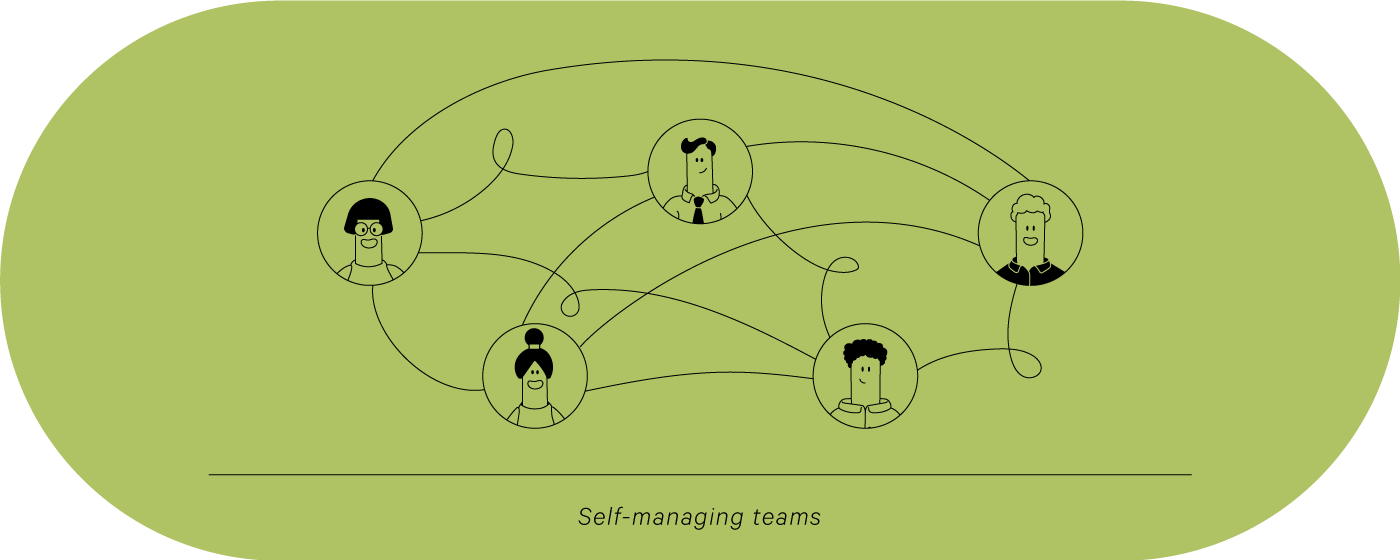
Typically, members of self-managed teams are employees of the same organization who work together, and even though they have a wide array of objectives, their aim is to reach a common goal. There is no manager nor authority figure, so it is up to members to determine rules and expectations, to solve problems when they arise, and to carry shared responsibility for the results.
One of the first major companies that decided to implement self managed teams was software company Valve in 2012. Around 300 employees have neither bosses nor a formal division of labor. Instead, they are expected to organize themselves around individual or group projects and are obligated to take care of customer support themselves. The work ethic at Valve relied heavily on individual responsibility.
When setting up a self-managed team, you have to define two parameters:
- Levels of responsibility
- The autonomy that is given to the self-managed team
Research has shown that employees in self-managed teams feel more useful on the job and find their jobs more challenging, although there is no proof that they are actually more productive.
Advantages and Disadvantages of Self-Managed Teams
Advantages:
- Autonomy improves employee motivation;
- Team members can manage their own time and handle tasks when it suits them;
- You don’t have to pay for an office;
- Shared responsibility instills pride in team accomplishments.
Disadvantages:
- The lack of hierarchical authority can put personal relationships over good judgment;
- It can lead to conformity that suppresses creativity and critical thinking;
- An added layer of responsibility is time-consuming and requires skills that some people simply don’t have;
- Training time and costs are higher due to a broader scope of duties.
Virtual (Remote) Teams
Virtual teams are made up of people who work in different physical locations and who rely heavily on collaboration tools to get things done together. Virtual teams provide members with a better life-work balance and allow business owners to employ the best experts in the field, regardless of the fact that they live on another continent.
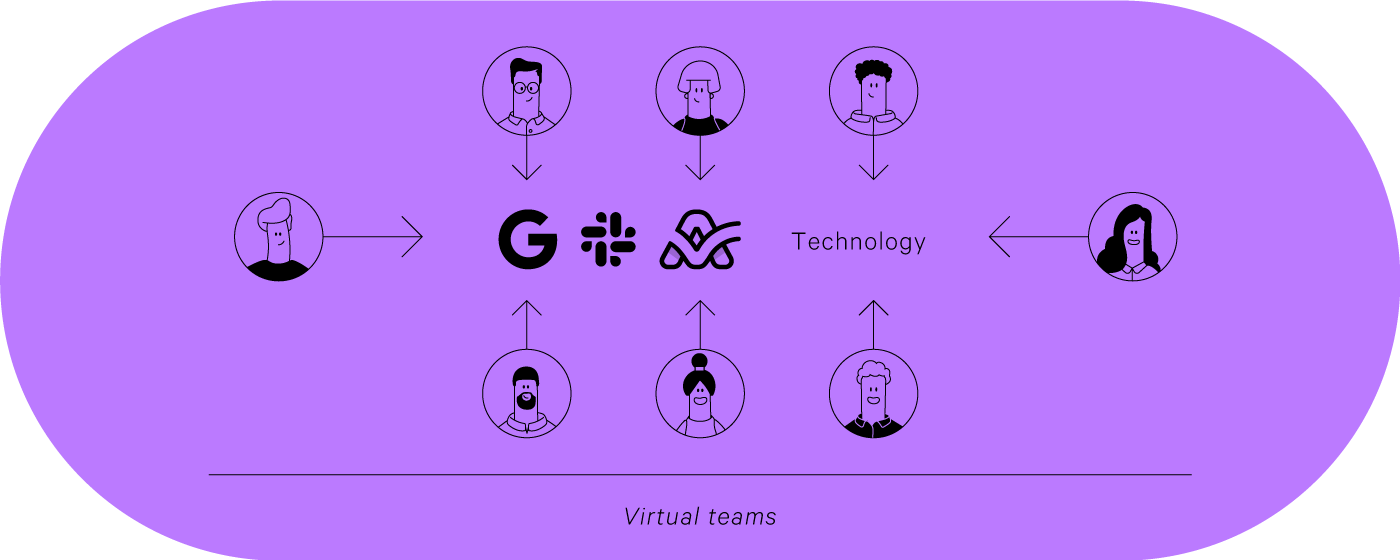
One of the organizations that had the most success with its virtual teams is Automattic, best known by their company, WordPress. Over 100 employees in 43 different countries use WordPress plugin P2 that enables them to communicate with each other in real-time. Also, when a new employee gets on board he receives a $2.000 stipend to improve his home office, gets the latest Macbook, and an open “time off” policy to use to take free time whenever they need.
It may seem a little farfetched, but this policy is one of the key factors behind Automatic’s success: WordPress is now used by 40% of websites globally.
Remote employee monitoring is so different from monitoring staff in an office environment. It demands huge trust, as well as having efficient communication channels set up. You have to learn to read a person's emotions and level of confidence without being able to see their face – which is hard.— Cam Lee, Rock Agency
Types of virtual teams
According to the Manager’s guide to virtual teams, virtual teams are characterized by three dimensions:
- Time - WHEN people work. They could work during different hours, on different shifts, or in different time-zones.
- Space - WHERE people work. They could be working right next to each other or hundreds of miles away.
- Culture - HOW and WHOM people work for. ‘Culture’ dimension includes factors such as gender, race, language, profession, education, nationality, as well as political, social, religious, and economic factors.
Operational teams
Operational teams support other types of teams. They are formed to make sure that all back-office processes go smoothly.
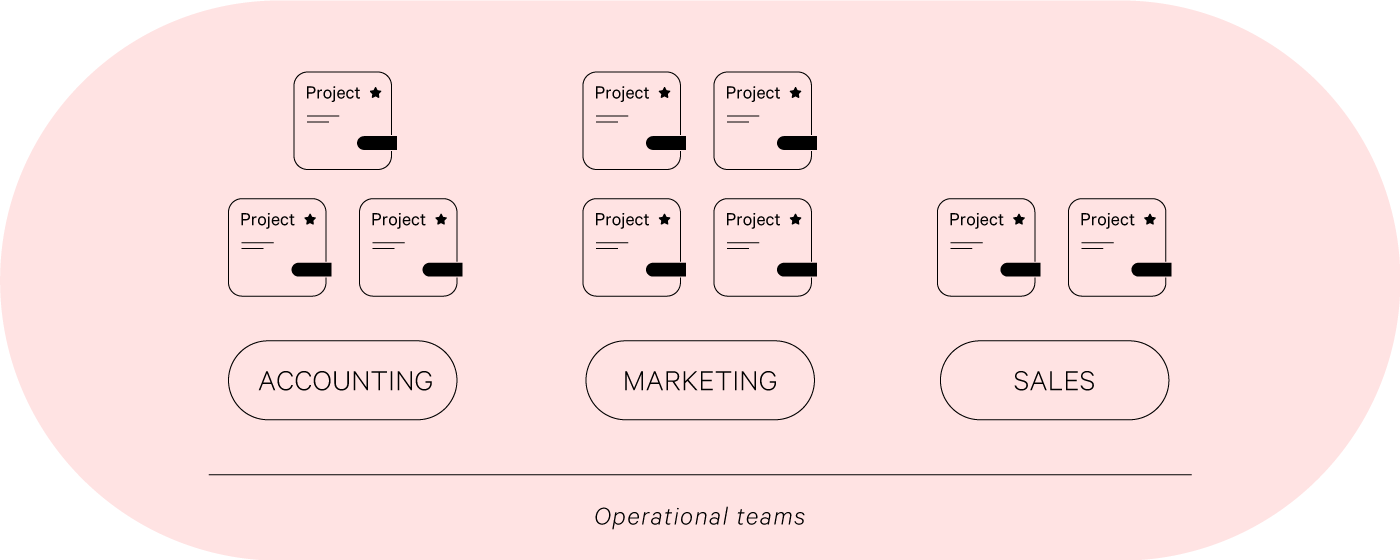
For example, the Human Resource department doesn’t handle any projects but it has to perform candidate screening, interviewing, and recruiting. If one of the key players decides to leave, HR has to find a substitute so the respective team can carry on its work.
Also, operational teams can have their own projects and function like a project team because they have well-defined roles and responsibilities. For instance, if the accounting department received a task to make an annual financial report by a certain date, they will most likely devise a timeline, delegate tasks, and keep track of deadlines just like any other project team.
What type of team is right for you?
When choosing a type of team to perform a certain task, ask yourself these questions:
- What’s the team’s purpose exactly?
- How many people are required, and what will their roles be?
- Are selected members capable of self-management, or they require a strong leader?
- Is it necessary for them to be located in a single place?
- Is their engagement temporary or permanent?
If you have a project that requires input from marketing, design as well as the Customer Support department, choose a cross-functional team.
"An effective team would demonstrate:The willingness to teach one another,Clear communication,High morale to maintain inspiration,Fill in gaps for one another (skill, time, circumstance),Strong as an individual, unstoppable as a group."— Kalila Lang, DigiSomni
If, on the other hand, you choose to outsource the design, and the agency you have chosen uses a designer that works remotely, the only logical way to go is opting for a mixture of virtual and contract teams.
In practice, you will rarely find a team that can be defined as solely functional or solely virtual: most teams in modern business represent a hybrid of some, if not all of the team types
